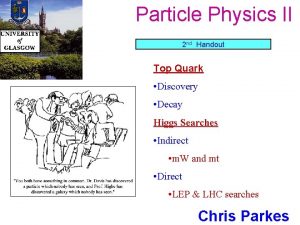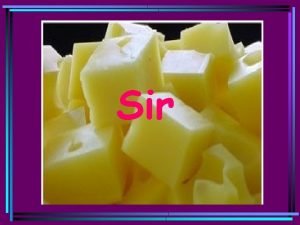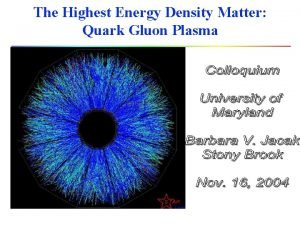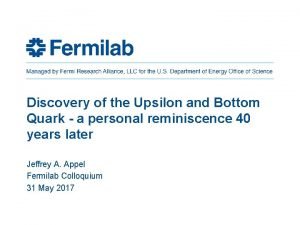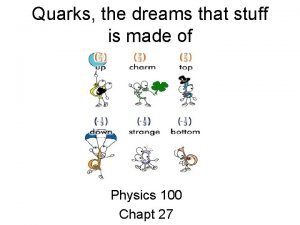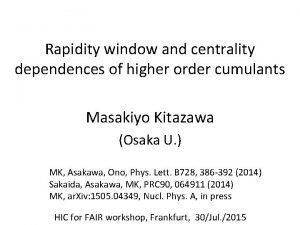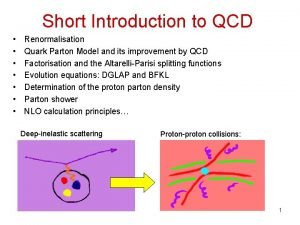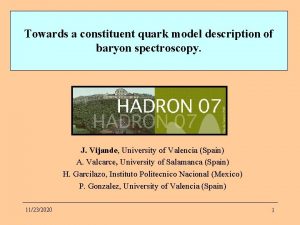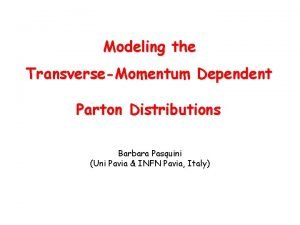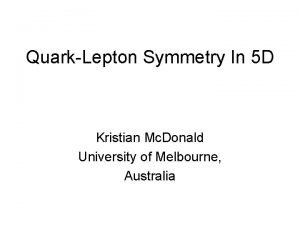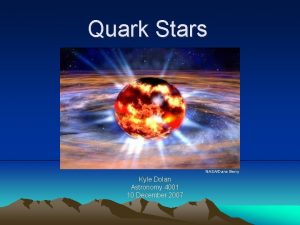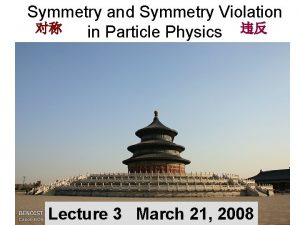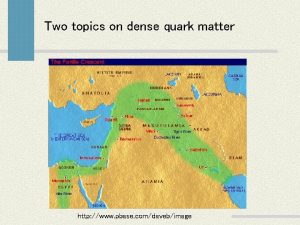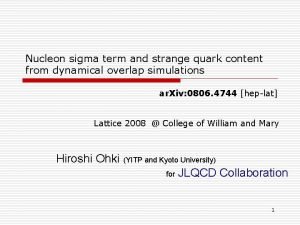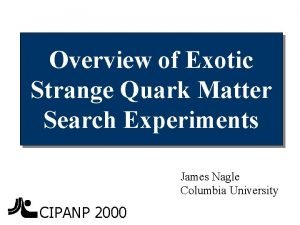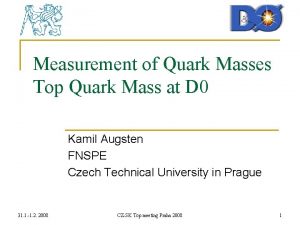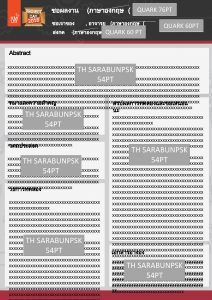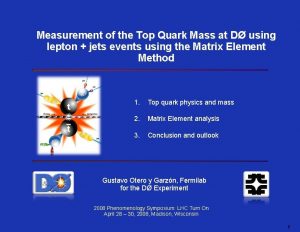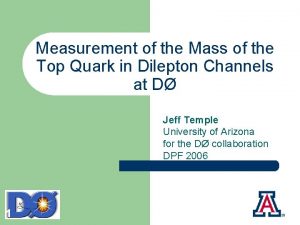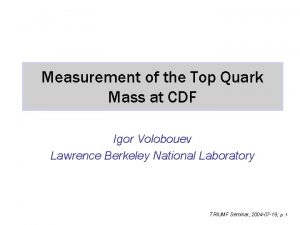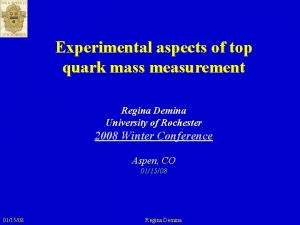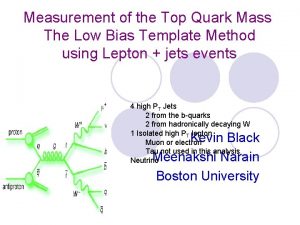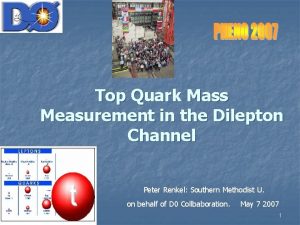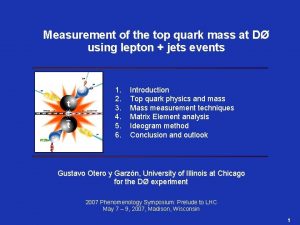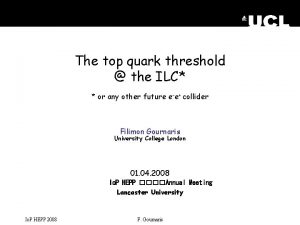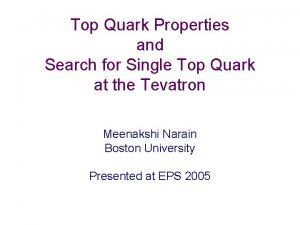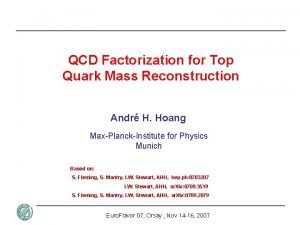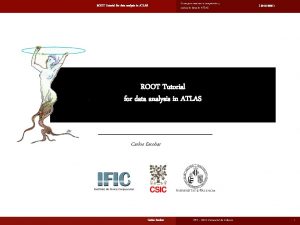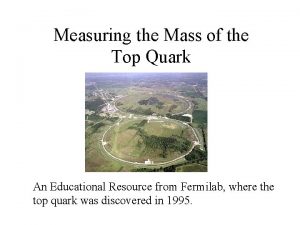1 Measurement of the Top Quark Mass with






















- Slides: 22

1

Measurement of the Top Quark Mass with the Template Method in the ttbar >lepton+jets Channel using ATLAS Data The Atlas Collaboration Anthony Hawkins on behalf of the Best Group Ever

Backup 3

Measurement of the Top Quark Mass with the Template Method in the ttbar >lepton+jets Channel using ATLAS Data The Atlas Collaboration Anthony Hawkins on behalf of the Best Group Ever

Outline • • Introduction The ATLAS detector Event preselection Template method 1 d analysis 2 d analysis Systematics Results/Conclusion 5

Introduction • Precision measurements of the top and W mass provide a better constraint on the Higgs mass than the combination of many EW observable • Plays an important role in many extensions of the SM • Constrain gluon PDF at larger x • Direct background in H -> W+ W- ~ 177 k tt pairs expected in 1. 04 fb-1 • The mass of the top quark has been measured with high precision (< 1%) at CDF and D 0: mt = 173 ± 0. 6(stat) ± 0. 8(syst) Ge. V (ar. Xiv: 1107. 5255)

ATLAS Detector Magnet system: B=2 T in ID from solenoid B=0. 5 1 T from toroid Muon Spectrometer: |η|<2. 7 Air core toroids and gas based muon chambers σ/p. T = 2% @ 50 Ge. V to 10% @ 1 Te. V (ID+MS) y-axis h=-ln tan(q/2) q Inner Detector: |η|<2. 5 Si pixels/strips Trans. Rad. Det. σ/p. T = 0. 05% p. T (Ge. V)⊕ 1% EM calorimeter: |η|<3. 2 Pb LAr Accordion σ/E = 10%/√E⊕ 0. 7% Hadronic calorimeter: |η|<1. 7 Fe/scintillator 1. 3<|η|<4. 9 Cu/W Lar σ/Ejet= 50%/√E⊕ 3% z-axis Trigger system: 3 levels to reduce 20 MHZ collision rate to ~300 Hz of events to tape 7

Single lepton decay (1) 8

Single lepton decay (1) 9

Single lepton decay (1) 10

Single lepton decay (2) • BR(t -> Wb) ~ 1 • BR(W -> lν)_ = 0. 108 (for each l = e, μ, τ) • BR(W -> qq) = 1 − 3 x 0. 108 = 0. 676 ➥ BR(DILEPT. ) = (3 · 0. 108)2 ∼ 11% ➥ BR(FULLY HAD. ) = 0. 6762 ∼ 46% ➥ BR(SINGLE LEPT. ) ∼ 43%* * τ channel not used here Main backgrounds (common to 1 d & 2 d analysis): • W+ jets (major background) • QCD multijet (fake high-p. T lepton & MET mis-measurement) • Z+ jets (missing one lepton & bad jet recons. ) • ZZ/WZ/WW (minor background) 11 • Single top (only for the 2 d analysis)

Event preselection Common requirements for 1 d & 2 d analysis: Cut µ+jets e+jets Lepton Transverse Energy p. T>20 Ge. V p. T>25 Ge. V Pseudorapidity |η|<2. 5 |η|<2. 47 excluding 1. 37<|η|<1. 52 Missing ET ETmiss > 20 Ge. V ETmiss > 35 Ge. V Transverse Mass ETmiss + m. TW > 60 Ge. V m. TW > 25 Ge. V Isolation ET (ΔR =0. 2)<3. 5 Ge. V ET (ΔR=0. 3)<4 Ge. V Jets (Anti-kt R=0. 4) ≥ 4 jets & p. T>25 Ge. V & |η|<2. 5 & >=1 b jet. Specific requirements, depending on the analysis (1 d or 2 d), will 12 be further described

Template method • Choice of observables xᵢ which are sensitive to m • Create MC Samples for different m : 160, 172. 5, 175, 180, 190 Ge. V • Find continuous parametrization of shape of xᵢ as function of m (and other parameters) • Estimate m from DATA distribution top top 1 -d mtop, nbckg • In this ratio the dependency on the JES scale is reduced significantly 2 -d • Fitting m_{top}, JSF, n_{bkg} • JSF as a fitting parameter 13

1 D Template • Selection of the top associated jets: kinematic likelihood relating the objects to the t t decay products predicted by Monte Carlo (MC@NLO) • Maximum likelihood built from the 4 jet combinations per each event • Use the reconstructed four vectors objects (jets and leptons) and Missing Transverse Momentum • The maximized value of the likelihood discriminates mismatches and correct matching (cut at -ln L=50) T Transfer function between reconstructed objects and MC generator level matched objects B Breit Wigner functions modeling the top and W masses. Wbtag Weights containing b-tagging information 14

1 D Template • Combination of single top and t t contribution for each choice of mtop • Parametrization of R 32 templates by a ratio of two gaussians ( for the two mass distributions) summed to a Landau (modeling the tail contribution) • Linear assumption on the parameters dependance to mtop • Overall χ² minimization of R 32 at all mass points • Template fit with binned likelihood for signal yield and top mass • Performance of this algorithm tested with pseudo-experiments - Poisson statistics for signal events predictions) - Background fluctuations around expected values (S. M. - Linearity between input and estimates e +jets μ+jets 15

2 D Template Construct jet triplet, 1 b jet & 2 light jets reco with b jet Build m top (unscaled) and light jets(scaled) reco Build m with unscaled W light jets Construct templates with JSF varied from 0. 9 1. 1 and mtop from 160 190 Ge. V Parameterize likelihood functions with the templates.

2 D Template (Cont'd) Parametrization found to have good linearity for JSF and mtop Maximized likelihood with data and found e+jets: mtop=174. 3± 0. 8 stat± 2. 3 syst Ge. V μ+jets: mtop=175. 0± 0. 7 stat± 2. 6 syst Ge. V

Systematic Uncertainties • vary parameters ± 1 s • run pseudo-experiments with changed parameters • add in quadrature, no correlation Largest contributions: 1 d template 2 d template Jet energy scale 0. 71% 0. 38% b-jet energy scale 0. 67% 0. 91% ISR and FSR 0. 81% 0. 58% • Jet energy scale: TOTAL • Impact smaller than JES itself: • minimized in R 32 observable for 1 d fit. • constrained in 2 d fit. 1. 43% 1. 32% • b-jet energy scale • Differences in fragmentation and hadronization of jets from light-quarks and bquarks 18 • ISR and FSR • pseudo-experiments with dedicated signal samples where Pythia shower parameters are varied.

Conclusion • Top mass measured using 2 different methods • Both mitigating the impact of the 3 largest systematics mt = 174. 5 ± 0. 6(stat) ± 2. 3(syst) Ge. V (2 d analysis)

Back up slides 20

Full systematics 21

Backup 22 Jun 16, 2012
 Top quark decay
Top quark decay Sirutka u prahu vindija
Sirutka u prahu vindija Quark gluon
Quark gluon Quark matter 2022
Quark matter 2022 Quark names
Quark names Quark names
Quark names 6 types of quarks
6 types of quarks Quark gluon plasma
Quark gluon plasma Quark parton model
Quark parton model Constituent quark model
Constituent quark model Barbara pasquini
Barbara pasquini Quark lepton symmetry
Quark lepton symmetry Quark astronomy
Quark astronomy Physics wordle quark
Physics wordle quark A charm quark has a charge of approximately
A charm quark has a charge of approximately Quark gluon
Quark gluon Sigma quark composition
Sigma quark composition Quark gluon
Quark gluon Quarks
Quarks Si unit ladder
Si unit ladder Stoichiometry worksheet #2 (mole-mass mass-mole problems)
Stoichiometry worksheet #2 (mole-mass mass-mole problems) Mass mole
Mass mole Atomicity
Atomicity
